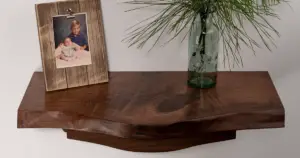Live Edge Table | Tables of Your Dreams
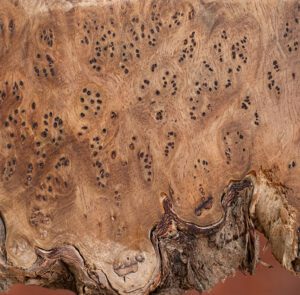
Live Edge Tables | What are they?
A live edge table is a piece of furniture with a wood top that has a raw, unfinished edge running along one or more of the tabletop’s sides. At Dovetails and Stitches, we remove the bark 99% of the time; we can talk about why later. This edge is left unmilled and keeps the natural features and flaws of the tree so the wood grain, knots, insect marks, crack, and other natural elements are well displayed on live edge tables. Live Edge slabs can make all kinds of tables, desks, bar tops, etc. Live edge tables can be most any shape (depending on the slabs we can find), even round tables (we call those slabs cookies).
Live Edge Tables | Selecting The Wood
A number of woods, including hard woods like oak, walnut, and maple, as well as softer woods like pine, can be used to create live edge tables. The presence of the raw, natural edge is the distinctive feature of the tables, which can vary in size, shape, and design. The legs or bases of live edge tables can be made of metal, wood, or even stone.
Burl or crotch wood live edge tables are very beautiful because of the distinctive, organic patterns in the wood. Due to its exquisite, unique appearance, burl wood, which has a swirling grain pattern, is frequently utilized in furniture and decorative objects. Crotch wood is formed when a tree fork or branch grows, and it features a distinctive grain pattern that is highly prized by woodworkers and furniture makers. Both burl wood and crotch wood can add a highly unique and organic touch to a live edge table, making them particularly striking and eye-catching. Overall, live edge tables made from burl wood or crotch wood are highly prized for their stunning, one-of-a-kind appearance. More on burls and crotches a little late in this article.
The natural appearance of live edge dining tables is popular because it may provide a dining room warmth and charm. They are also valued for being distinctive because each table is special due to the inherent differences in the wood. Traditional dining tables constructed from processed, uniform wood can be replaced with beautiful live edge tables that are also environmentally friendly.
Other live edge ideas below.
Click the link for more live edge ideas. (Link here)
Kitchen
Although this page is really all about live edge tables and using the slabs in furniture making. We would be remiss if we didn’t, at least, briefly talk about using live edge slabs in the kitchen. These live edge slabs also make beautiful and resilient countertops and islands. And by resawing and milling thick-cut slabs we even create cabinet doors. Ok, enough about the kitchen.
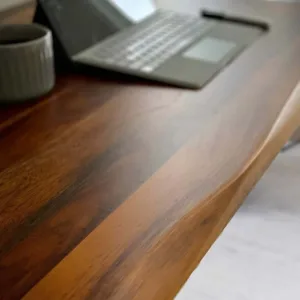
Table
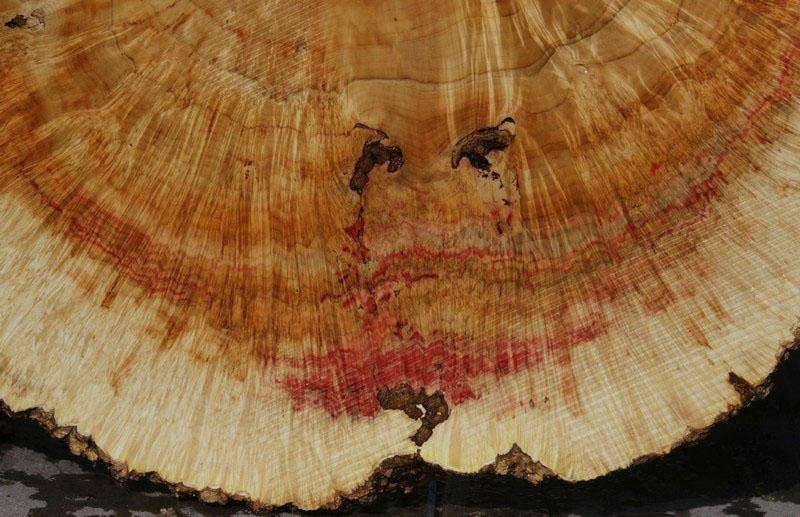
A Box Elder Cookie
Just waiting to become a table top. A blend of creamy orange and vanilla hues with pink and raspberry accents
The slabs with live edges on them can be used to make all sorts of table tops including coffee tables, end tables, nightstands, etc. Use your imagination, if it has a top, it could have a live edge top. For the sake of this article, we are not talking about making a river table. We have other posts dedicated to that topic separately like this blog on a Padauk River Table here.
Live Edge Tables
Live edge tables from Dovetails and Stitches can be made from almost any tree you can imagine. We have suppliers from all over the world we source slabs from. Some of our popular choices are hardwoods (for the obvious reason of durability) like Oak, Walnut, Hard Maple, Cherry, Hickory, and Pecan just to name a few.
Soft(er) woods also make excellent live edge table. Woods like pine (make for a more rustic), Redwood, and even Cedar make beautiful live edge dining tables. Although from a maker’s point of view, creating one in the shop can be very different. For example, Cedar needs much more support, but we’ve got you covered on the creating side, so no worries.
Benefits of Live Edge Tables
One of the main benefits is the unique and natural appearance of each table. Because live-edge tables are made from natural wood and retain the raw, unfinished edge of the tree, each table is one-of-a-kind and showcases the unique character and beauty of the wood. This adds warmth, charm and I argue personality to a dining room or boardroom and makes it feel more comfortable and inviting.
Another benefit of live edge tables is their durability and sustainability. Natural wood is generally more durable and long-lasting than processed wood or synthetic materials, making it a good choice for furniture that will be used frequently. Live edge tables made from hardwoods like oak or walnut can especially be expected to last for many years. In addition, using natural wood for furniture can be a more environmentally-friendly option compared to using processed or synthetic materials. (Cut the big box store cord).
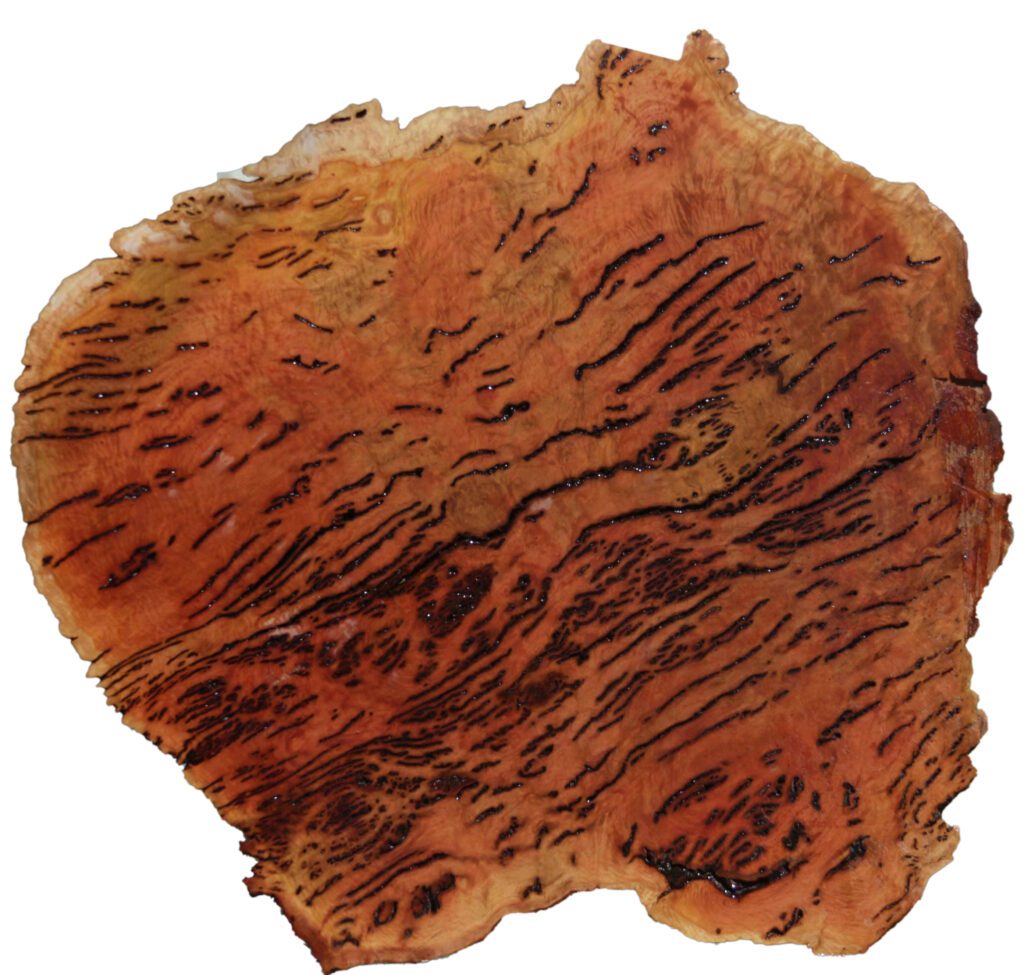
Austrailian Red River Gum Burl
Live Edge Dining Table Design Ideas
Live edge tables are also highly versatile in terms of design, as they can be customized to fit a variety of décor styles. Whether you prefer a rustic, natural look say a Ponderosa Pine with country Sheraton or Fluted Sheraton style legs or a more modern, sleek style, a live edge table say from Dark Walnut, with brass bowties and a set of modern steel (powder coated) legs. Everything can be tailored to fit your preferences.
Each Tree is unique, and no two tables are exactly the same. The slab choice and its characteristics will largely determine the final shape and dimensions. We will work with each customer to find the perfect slab for their style and needs! If you’re not local, no problem, we can facetime or zoom and show you all the options we have available. And if we don’t have something perfect for you, we will find it for you! The tree itself will help dictate design, the shape of this Figured Pomelle Sapele Slab, for example would make a fabulous two person desk.
The natural edge of the table can be finished in a variety of ways, such as with a clear sealant, a stain, or even epoxy to enhance and protect the wood and achieve the desired look. Because of how nature works, specifically around the drying of sap and heartwood versus the bark. We almost always remove the bark from our tables and take care of smoothing out the edge to make it safer to use. I mean like no sharp edges (like where a small branch was growing out of the side of the tree).
Overall, live edge dining tables offer a unique and natural appearance, durability, sustainability, and versatility in terms of design. These benefits make them a popular choice for those looking to add more personality to their dining room. I should add, they are one of our favorite styles of tables to make as well! Watching the natural beauty reveal itself is really rewarding.
A few more points to consider when it comes to the benefits of a live edge dining table:

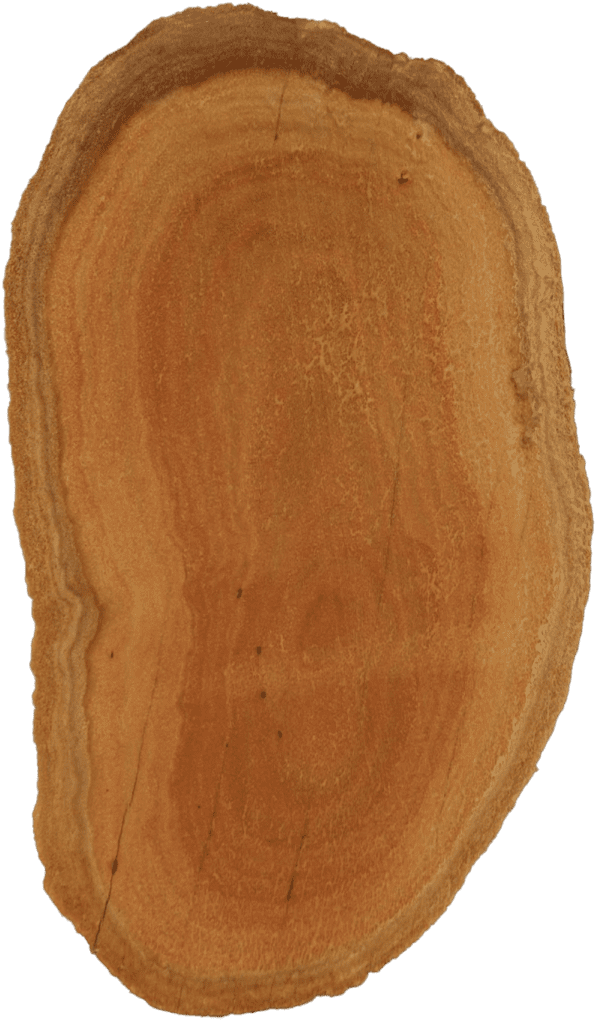
Care and Cleaning of Your Live Edge Table
This section is a general guide, since every table is unique, every customer will receive a specific care guide for their table with their specific finish.
Caring for and maintaining a live edge dining table involves a few simple steps to keep the wood in good condition and preserve its natural beauty. Here are some tips for cleaning and protecting the wood surface, as well as suggestions for preserving the natural edge:
- Clean the table regularly using a soft, dry cloth or a slightly damp cloth with a small amount of mild soap. Avoid using harsh chemicals or abrasive cleaners, as these can damage the wood or finish.
- Protect the wood surface from excess moisture by using coasters under drinks and placing placemats or a tablecloth on the table. Excess moisture can cause the wood to warp or crack, so it’s important to avoid allowing liquids to sit on the surface for extended periods of time.
- Protect the table from scratches and dents by using protective pads or coasters under heavy objects and avoiding placing sharp objects on the surface.
- The type of finish on the table will affect how it should be cared for. A live edge table with a shellac finish, for example, should be cleaned with a dry cloth and should not be exposed to excess moisture. A table with a varnish finish can be cleaned with a slightly damp cloth and may be more resistant to moisture, but it should still be protected from excess liquid. An epoxy resin finish is highly durable and resistant to moisture, but it should still be protected from scratches and dents.
Overall, the key to maintaining a live edge dining table is to keep it clean and protected from excess moisture and damage. By following these simple care tips, you can keep your live edge table looking beautiful for years to come.
History
The origins of the live edge table can be found in early civilizations where furniture was crafted from raw materials like wood, stone, and bamboo and was rather rustic due to the available tools.
This historical section was added since the live edge style has grown in favor recently as a means of incorporating the natural beauty of wood into furniture design. And as a designer, I love to see that, and my all-time favorite designer, American furniture maker and carpenter George Nakashima, was probably the main factor in it. George was well known for his organic, simple designs. His work, which often featured live edge wood, was influenced by his time studying traditional Japanese woodworking techniques.
Other designers and movements, such as the Arts and Crafts movement and the Mid-Century Modern movement, also embraced the use of natural materials and unfinished edges in furniture design. In recent years, the live edge style has continued to grow in popularity as a way to bring a natural, rustic touch to modern design. And we couldn’t be happier about this!
One of my favorite wood quotes comes from Mira Nakashima, George’s daughter.
“The wood is our muse and our palette; its shapes and colors speak to those who listen.”

